

Page updated 20th July 2014 - three items
Around the city in the 1930's
Film from the 1930s
Standfield & White - the garage
Garton & King in Waterbeer Street

 The Coronation 1937
The Coronation 1937
Left is an unpublished view down the High Street from Castle Street,
towards Bedford Street. The building on the far corner is the much
loved Dellers Cafe. The
decoration of flags and bunting are to celebrate the Coronation of King
George VI in 1937, which begs the question - why is the Stars and
Stripes hanging from Dellers? Photo courtesy of Pam Salzman - it was
taken by her grandfather. The photo below shows the residents of
Beaufort Road, St Thomas enjoying a street party for the Coronation.
Photo courtesy of John Garnsworthy.
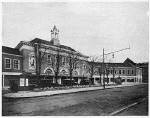
 Central Station, Queens Street replaced
the old Southern Railways station in 1934.The original Queen Street
Station which opened in the 1860's was burnt down in 1927. Courtesy
Exeter City Council - Photo left David Cornforth
Central Station, Queens Street replaced
the old Southern Railways station in 1934.The original Queen Street
Station which opened in the 1860's was burnt down in 1927. Courtesy
Exeter City Council - Photo left David Cornforth

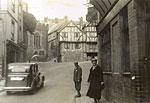 Westgate
between Rack Close Lane
and West Street
Westgate
between Rack Close Lane
and West Street
The postcard top left
dates from the early 1930's. The central, historically interesting
house was demolished in preparation for a road scheme. In 1961, the
site was used for the House
That Moved. Rackclose
Lane on the left, hard against the outer city wall once
stretched almost as far as the Snail Tower before New Bridge Street was constructed in 1782. The bottom photo is at right angles to the
previous picture and was taken from Edmund Street looking towards
Stepcote Hill. The Teignmouth
Inn is near right while the entrance to Rackclose Lane is
positioned where the tree pokes out on the left. Photo right, courtesy
of Dick Passmore.
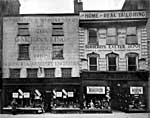
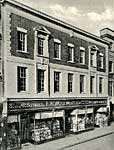 Garton
and King (right) and Pinder
and Tuckwell vacated their High Street shops in 1933. The
sale was described by Henry Holladay in his memoirs. In 1934, Woolworths moved
from the old Lloyds Tobacco Factory at the top of Fore Street (next to
the Hogs Head) into the Garton and King building (bottom right). In
1934, Woolworths boasted that nothing cost more than sixpence (2.5
pence). The store was closed when they moved to the Guildhall Centre in
the 1980s and the shop is now McDonalds and HMV.Photo top
courtesy of Richard Holladay
Garton
and King (right) and Pinder
and Tuckwell vacated their High Street shops in 1933. The
sale was described by Henry Holladay in his memoirs. In 1934, Woolworths moved
from the old Lloyds Tobacco Factory at the top of Fore Street (next to
the Hogs Head) into the Garton and King building (bottom right). In
1934, Woolworths boasted that nothing cost more than sixpence (2.5
pence). The store was closed when they moved to the Guildhall Centre in
the 1980s and the shop is now McDonalds and HMV.Photo top
courtesy of Richard Holladay
 The Dolphin Inn at Burnthouse Lane
The Dolphin Inn at Burnthouse Lane
The Dolphin Inn on
the corner of Laurel Road and Burnthouse
Lane, just months after the builders had vacated. The Burnthouse Lane estate, substantially completed in 1932, was designed by John Bennet
with 12 houses to the acre along with a new school, a pub, shops and
recreation ground. It was mostly families from the West Quarter and Exe
Island who were rehoused
 Boots Corner 1936
Boots Corner 1936
This building on the corner of Queen and High Street was been replaced
by the C&A building in the 1970s. It is now occupied by JJB
Sports and Tesco Metro. Before it was Boots, Wheatons ran a bookshop from the premises.
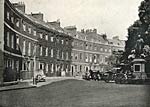
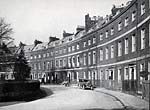 Bedford Circus
Bedford Circus
These two photos of Bedford Circus show the western and eastern ends of the north side. The house covered with vegetation can be seen on both photos. Within a few years the buildings had gone, destroyed by incendiary bombs in 1942 .

 Deller's Cafe & Flannel Dance
Deller's Cafe & Flannel Dance
Deller's Cafe heyday was the 1930s, when visitors and locals enjoyed the sumptuous interior to be entertained by an orchestra as they had afternoon tea, of danced into the small hours. The photo left show the grand staircase and elaborate plaster decoration. In August 1931 they held a Grand Flannel Dance – Sylvia Gribble kindly supplied the scan of the ticket.
 Silver Jubilee of George V New
Silver Jubilee of George V New
On the 6 May 1935, Exeter celebrated the Silver Jubilee, and issued this souvenir programme. There was a bonfire at Pennsylvania, fireworks near Barley Lane, floodlighting of the Cathedral and Washington SInger Building and St Luke's College, street decorations and a Royal Salute and band concerts.
 New Coronation of George VI
New Coronation of George VI
George V died on 20 January 1936. His eldest son became Edward VIII – but his love for Wallace Simpson created a constitutional crises, and he abdicated on 11 December 1936. His brother Bertie succeeded, becoming George VI. Preparations for Edward's Coronation were hastily rearranged for George VI who was crowned on 12 May 1937. Exeter celebrated the event with a Loyal Address and a full day of events that were listed in the official programme, pictured right.
Exeter was visited by a number of British and Foreign Royal Persons during the 1930s including:
- nice of him to spare the time!
Prince Takamatsu of Japan in March 1931
Princess Catherine of Greece in 1932
Princess Frederik of Brunswick, grand daughter of the Kaiser in 1934
Queen Mary in 1938 who visited the Guildhall, Cathedral and Hope Hall
and the Princess Royal visited St James Park in 1939 to inspect a county parade of the British Red Cross
The Mayor must have had his ceremonial hat glued on with that little lot!
 Hamlyn Lane
Hamlyn Lane
A photograph of Hamlyn
Lane in the early 1930s. The houses look very new, while
the road has not yet been surfaced, and is still rough. Polsloe Bridge
Station is behind. Also see Swansborough
photo essay Photo courtesy of Adam Bigg.
 New
London Inn
New
London Inn
One of the most famous hotels in Exeter,
it was situated in New
London Square. The hotel was purchased by the Associated
British Cinemas and closed on 2nd November 1935 and demolished in
February 1936 to make way for the Savoy
Cinema.
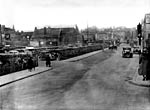
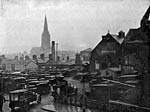 Paul
Street
Paul
Street
Top left, looking up Paul Street in the mid 1930s. The new Paul Street Bus Station, at the top opened in 1929. The sharp eyed will
notice at the top, the Exeter Tourist Bureau and the bus station. The
photo on the right shows the car park in Paul Street - the church is St Michael's, Mount
Dinham, with the chimney of St
Anne's Brewery in front. The buildings on the bottom left
appear to be a church hall and malthouse, since demolished. The whole
are is now the carpark for the Harlequins
Centre. Why is a hearse queuing for parking? Courtesy
the City Council Parks Department.
 Garton
& King in
Waterbeer Street 1936
Garton
& King in
Waterbeer Street 1936
Film kindly provided by the Holladay family
 Penguin Books inspired
by Exeter - Allen Lane, a director of Bodley Head found
himself on the platform of Exeter
St David's Station one evening, after visiting Agatha
Christie in Paignton. Browsing the bookstall, which offered only
magazines and Victorian novels, it occurred to him there was a market
for quality, but cheap books. He started Penguin paperbacks, the first
of which were sold in the summer of 1935. Books by quality authors such
as Ernest Hemingway, André Maurois and Agatha
Christie could be purchased for sixpence, the price of a
packet of cigarettes. They were colour coded - orange for fiction, blue
for biography, green for crime.
Penguin Books inspired
by Exeter - Allen Lane, a director of Bodley Head found
himself on the platform of Exeter
St David's Station one evening, after visiting Agatha
Christie in Paignton. Browsing the bookstall, which offered only
magazines and Victorian novels, it occurred to him there was a market
for quality, but cheap books. He started Penguin paperbacks, the first
of which were sold in the summer of 1935. Books by quality authors such
as Ernest Hemingway, André Maurois and Agatha
Christie could be purchased for sixpence, the price of a
packet of cigarettes. They were colour coded - orange for fiction, blue
for biography, green for crime.
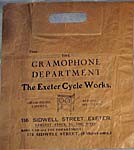
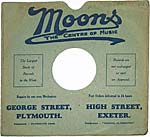 Record shops
Record shops
Left is a paper bag for the Gramophone Department of the Exeter Cycle
Works of Sidwell Street. They started selling records in the late 1920s
from the cycle shop. It was common for bicycle dealers to sell
gramophones and records, probably because the internal mechanics could
be looked after by a cycle engineer. They eventually became the Exeter
Pram and Toy Shop. Moons, in the High Street, who are remembered by
many for their pop records in the 1960s, were established selling
musical instruments. The record cover from the 1930s, was for the old
10 inch, 78 rpm, shellac records which were introduced about 1925. Courtesy of Peter
Rice and
Peter Hawkins.
The Match Factory suspension bridge near Trews Weir was constructed in 1935. It was built by Willeys to provide a crossing for those on the new estates at Burnthouse Lane, to walk to work to their foundry.
The Reverend Charles Curzon was enthroned as Bishop of Exeter on 7th December 1936.
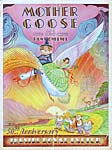 Mother Goose and Little Snow
White - 1938
Mother Goose and Little Snow
White - 1938
The 1938 panto at the Theatre Royal was the 50th Anniversary of the
first panto when the theatre was opened in 1888. It was written by
Uncle Percy Dunsford who had become Acting Manager in 1897. He advised
the Directors to produce their own pantomime, rather than engage an
outside company, in 1909, resulting in the first home produced Red
Riding Hood. The 1937 panto attracted 60,000 people with
special
coaches bringing in audience from all over the region. Courtesy of Gill
Hollins.
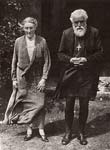
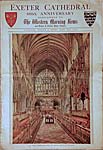 800
years of the Cathedral and Bishop Cecil - 1933
800
years of the Cathedral and Bishop Cecil - 1933
Rupert
Ernest William Gascoyne Cecil (Bishop 1916-36) was a somewhat eccentric
bishop who was noted for his long white beard and for riding a bicycle
around the city. It was said, that in the Bishops Palace, he fed
crumpets to rats and threw powdered copper sulphate on the fire to turn
the flames green. He was nicknamed 'Fish'. It was Cecil who ordered
that St Paul's Church in Paul Street be demolished in 1936. The
photograph appeared in a Western Morning News special supplement, left,
of the 24th June, to celebrate the 800th Anniversary of the Cathedral.
Courtesy of Gill Hollins.
The City Swimming Baths now called the Pyramids, in Heavitree Road opened in May 1939 by the Mayor.
The Devon and Exeter Gazette struggled on as a daily until 26th February 1932. It had first appeared in 1792.
The 400th Anniversary of Henry VIII granting Exeter its City Charter was celebrated by the Sheriffs of every city in Britain attending a service in the Cathedral in 1937. Pathe News were present, and filmed the parade of Mayors into the Cathedral.
Exeter's population in 1931 was 66,029.
The old cattle market in Bonhay Road closed and moved to Marsh Barton in 1939 - it was said that the Exe ran red from the blood discharged into the river.
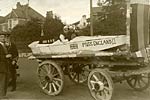 Miss
England II float at the
Exeter Pageant
Miss
England II float at the
Exeter Pageant
Henry Segrave, driving Miss
England beat Miss
America VII in
the World Motor Boat Championship in 1929, the first win for Britain in
seven years. In 1930, the now, Sir Henry Segrave was killed on Lake
Windermere trying to regain the world speed championship in Miss England II.
The boat was salvaged and in 1931, Kaye Don raced Gar Wood on the
Detroit River for the Harmsworth Trophy - Miss England II flipped over in the wake of America
IX and both boats were disqualified, giving the trophy to Miss America VIII.
This enthusiasm for speed was shared by the public, as shown by this
photo of a float at the Exeter Pageant of Miss England II from the early 1930s.
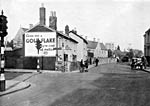 Livery Dole
Livery Dole
The junction of Magdalen Road and Polsloe and Barrack Road. Traffic
lights were introduced to Exeter in 1930. The Livery Dole almshouses
can be seen beyond the junction. Courtesy the
City Council Parks Department.
Motoring in the 1930s
 Standfield
and White
Standfield
and White
The cover for a booklet published by Standfield
& White of Sidwell Street with a range of drives around Exeter for the visitor. Motoring was
exciting at this time and it was a real adventure to tour Sidford,
Sidmouth, Colyford, Musbury and Axminster (56 miles)
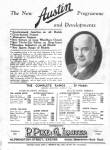 Pikes
Garage
Pikes
Garage
This advert for Pikes
Garage lists the range of Austins that they had for sale
during 1933. The advert emphasisis the mechanics and doesn't mention
quality, comfort nor safety. A Deluxe Austin Seven costs £128.

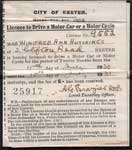 Exeter City Driving Licence
1930
Exeter City Driving Licence
1930
The Motor Car Act 1903 made it compulsory to tax a motor vehicle and to
obtain a driving licence. This driving licence for 1930/31 cost 5
shillings, and was issued by Exeter City Council. The driving test for
new drivers was not introduced until 13 March 1935, so the bearer of
this licence would have never passed her test. The year before the
introduction of the test, 7,000 were killed in motoring accidents. See Motoring in Exeter. Licence
copied courtesy of Aubone Braddon.
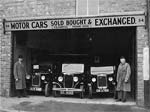 Seven
Stars Auto Sales, Okehampton Street
Seven
Stars Auto Sales, Okehampton Street
This garage
was run by Thomas Oliver Portus and his son, William Hodder Oliver
Portus. The directories in 1938 indicate the garage next to the Seven
Stars Hotel, although the street number in the photograph, places the
garage a few doors further up Okehampton Street. Photo
courtesy of James Oliver Portus
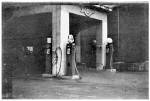
 Maudes
Garage 1934
Maudes
Garage 1934
The petrol pumps at the front of Maudes
Garage in New
North Road, around about 1934. Notice the four brands of petrol. The
business was owned by a Mr Pettit who took advantage of the Theatre Royal next door
for publicity stunts - elephants from shows were marched into the
showroom from Stable Yard between the theatre and the garage. An
advert, right, for Maudes featuring some of their luxury models, that
appeared in a Western Morning News supplement to celebrate 800 years of
Exeter Cathedral. Photo
and story supplied by Kevin Peters.
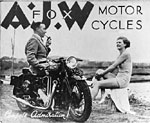
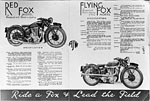 AJW Motor Cycles,
Frienhay Street
AJW Motor Cycles,
Frienhay Street
Part of a leaflet from 1937 for AJW
Motocycles who
manufactured motorcycles in Friernhay
Street. Arthur John Wheaton, of the printers, started the
company in 1926 from workshops adjacent to the printworks. In 1947 the
company was sold and relocated to Dorset. The two models of motorcycle
on this leaflet were the Red Fox and Flying Fox.
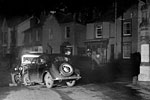 Car crash at the Clocktower
Car crash at the Clocktower
Not much is known about this photograph apart from it showing a head-on
car crash at the Clocktower in 1937. A serious accident, such as this,
was always photographed by the police. The Clocktower is on the right,
and from this angle, not much has changed in the buildings behind.
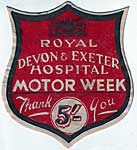
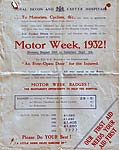 The Royal Devon
and Exeter
Motor Week
The Royal Devon
and Exeter
Motor Week
The growth of
motor traffic during the 1920s and 30's saw an increase in car
accidents. In 1927 the Royal Devon and Exeter Hospital ran its first
Motor Week, to raise funds for the casualty wards that treated the
injured. In 1932 motorists and cyclists were invited to purchase a
windscreen badge for 2/6 and 5 shillings, and also donate a sum, to
help fund the work. In 1928 they raised £1,020 and in 1930
£1,405.
 Exeter
City Police Training
Exeter
City Police Training
This early 1930's photograph shows trainee constables practising point
duty somewhere in Exeter. In the days before there were many traffic
lights, the police would direct traffic at a road junction. The photo
appears in a book, The Police, A Handbook for
Candidates and Constables, written by the Exeter City Police, Chief
Constable Frederick T Tarry and King's Gold Medallist. For those who
are interested, the constables are demonstrating the Number One Stop Signal a signal rarely used nowadays with modern traffic.
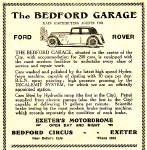 Bedford
Garage advert
Bedford
Garage advert
An advert for the Bedford
Garage, which was at the end of Bampfylde
Street behind Bedford
Circus and immediately opposite Bampfylde House. It was
opened by Pollards the printers who vacated their printing premises in 1931 to make way for the car.
Exeter police took delivery of their first patrol vehicle, a van with the registration FJ8300, in 1934.
The last tram ran in Exeter on the 19th August 1931 to be replaced by a new bus fleet. See History of transport in Exeter for more on the trams and history of the buses.
Aviation during the 1930s
May 1939, the Great Western and Southern Air Lines began a daily air service to Bristol, Exeter, Plymouth, Land's End, Isles of Scilly from Exeter Airport.
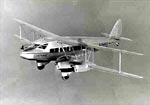 The
De Havilland DH86 was the first
airliner to land at Exeter Airport in 1937. See Airport History and Airport Photo Essay. Photo de Havilland Moth Club.
The
De Havilland DH86 was the first
airliner to land at Exeter Airport in 1937. See Airport History and Airport Photo Essay. Photo de Havilland Moth Club.
The Great Devon Air Race was first competed for in 1937. The winner was Captain Phillips flying an Avro 504N G-ADEV.
Exeter Airport opened on 31st May 1937. The first flight was a Jersey Airways DH86. It was welcomed by the Mayor who, along with other dignitories, was given a flight over the city. The first terminal was a tent. See Airport History
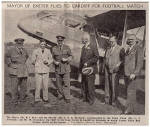 The
Mayor takes a flight The
Mayor of Exeter flew to Cardiff to watch City play Cardiff in August
1938. "The thrill of a
lifetime" said the Mayor. The 8 seater Rapide, had
formerly belonged to the Duke of Windsor. The return flight took 27
minutes. Exeter won 2 goals to 1.
The
Mayor takes a flight The
Mayor of Exeter flew to Cardiff to watch City play Cardiff in August
1938. "The thrill of a
lifetime" said the Mayor. The 8 seater Rapide, had
formerly belonged to the Duke of Windsor. The return flight took 27
minutes. Exeter won 2 goals to 1.
 New Sir Kingsley Wood, Secretary of State for Air opened the new Exeter Airport Terminal on 30th July 1938. See Airport History. This leaflet was enclosed in the official city guide book in 1938.
New Sir Kingsley Wood, Secretary of State for Air opened the new Exeter Airport Terminal on 30th July 1938. See Airport History. This leaflet was enclosed in the official city guide book in 1938.
Cinema in the 1930s
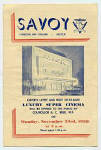 Savoy
Cinema
Savoy
Cinema
The programme for the opening of the Savoy
Cinema in 1936. The cinema survived the bombing and became
the ABC in 1960. The Beatles performed on its stage in 1964. Authors
collection
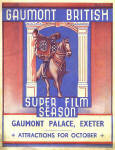 Gaumont Cinema
Gaumont Cinema
The programme for the opening of the Gaumont
Cinema on the 16th May 1932. The cinema survived the bombing,
only to succumb to the popularity of television - it closed in 1963 to
become a bingo hall.
 The
Theatre Royal
The
Theatre Royal
A programme from September 1935 for the Theatre
Royal. The show was Lilac Time a musical play set in Venice
during 1826. The programme cost 3d, while a seat in the circle was 3
shillings and in the pit, 2 shillings. Authors collection
The Odeon Cinema in Sidwell Street was opened on 30th August 1937 with the'Charge of the Light Brigade'. It had a seating capacity of 1,920.
The Plaza Cinema was opened on 6 February 1931 after the Hippodrome Theatre in London Inn Square was converted to show films. The first film in the new cinema was The King of Jazz with an appearance by a young Bing Crosby. It was in Technicolor
Promoting tourism in the 1930s
 The
Rougemont Hotel The
use of colour in an advert in 1933 was comparatively rare - especially
in the Exeter Guide. Rougemont
Hotel (Thistle Hotel) has used its famous stained glass
window depicting Richard III visiting Rougemont Castle before he was
killed at the battle of Bosworth Field..
The
Rougemont Hotel The
use of colour in an advert in 1933 was comparatively rare - especially
in the Exeter Guide. Rougemont
Hotel (Thistle Hotel) has used its famous stained glass
window depicting Richard III visiting Rougemont Castle before he was
killed at the battle of Bosworth Field..
 GWR Poster
GWR Poster
A GWR poster advertising Exeter as a place to visit in 1931 - it shows
a parade of Royalists during the Civil War in front of the Guildhall. Authors collection
Tinley's Teashop in Broadgate was opened by Mrs Tinley in 1930. The business expanded over the years and supplied savouries and cakes from its Sidwell Street premises around Exeter.
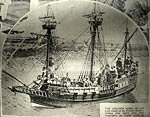 In July
1935, a half scale copy of Sir
Francis Drake's, Golden Hind was sailed up the Exeter
canal. The photograph, which appeared in the Western Times shows
some of the crew towering over the deck.
In July
1935, a half scale copy of Sir
Francis Drake's, Golden Hind was sailed up the Exeter
canal. The photograph, which appeared in the Western Times shows
some of the crew towering over the deck.
Bampfylde House was purchased by the City Council and opened to the public in 1934 - lost in 1942. It dated from 1590-94.
Shopping during the 1930s
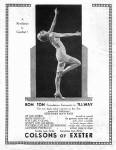 Colsons
Colsons
An advert from 1933 for Colsons of 30 High Street. From the end of the
First War, Art Deco was a popular style. The posing of the model for
underwear is very much styled on the bronze figures of the time. The
Rolls Royce 'Spirit of
Ecstasy' was another such female form.
 Brufords
Jewellers There
were many prominent businesses in the High Street in the first part of
the 20th century. Brufords was well known, as much for the fine, ornamental clock that was
situated outside the building. The shop was situated close to the
present day Dixons.
Brufords
Jewellers There
were many prominent businesses in the High Street in the first part of
the 20th century. Brufords was well known, as much for the fine, ornamental clock that was
situated outside the building. The shop was situated close to the
present day Dixons.
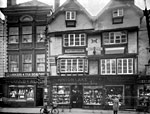 Hinton Lake & Sons
Hinton Lake & Sons
A old family run chemist, the shop was located in this interesting
ancient building of 41 High Street for many years. It was well known to
early photographers for photographic supplies. The building now houses Laura Ashley.
 Devon
and Somerset Stores
Devon
and Somerset Stores
Another business that has gone, it was situated in the High Street,
opposite Bedford Street. The store was opened by the Hare family who
lived at Honeyland's - the house became the Vranch House School. In
1920, the family moved to the Red House, Whipton.
War approaches
Six days after war was declared on the 3rd September 1939, 900 children had been evacuated to Exeter. The evacuees were welcomed by a large crowd at Northernhay after they arrived at Central Station. Most of the children were billeted in St Thomas.
Deller's Cafe opened its ballroom as a recreation centre for servicemen in the city on 13th September 1939.
Rabbi Lionel Blue arrived in Exeter as a young evacuee in September 1939.
On the day Germany invaded Poland, 1st September 1939, Exeter had its first practice blackout.
More interesting events in the 1930s
On 19th August 1931, the last tram to run in Exeter was driven by Cllr. Perry, who also drove the first electric tram in 1905. He was presented with a silver control handle for the last journey.
The lock keeper at the Double Locks, in the 1930s, found a human leg in a brown parcel when out patrolling his area. A search revealed a second leg, also in a brown parcel. The police sent divers into the canal looking for a body, but none was ever found. The police decided that a medical student had disposed of the legs.
A diary extract for the 13th November 1930 written on the 16th birthday of Exonian Gilbert Bell - Flight Lieutenant Bell served in the RAF as a bomb aimer, and was killed on 10th May 1944 in a bombing raid over Lille, France, for which he was awarded the DFC. He has no known grave:
"The traffic light signals have been introduced into the city during the past eighteen months. Last week there were altered improved two signals to each road being made, so there is now no excuse of not seeing the signals. I hear they are going to alter them to stop-go instead of stop-caution-go as they are now. I do not think that is likely, however as similar signals have yesterday been installed at the bottom of Paul St. and at Livery Dole I think Wonford Road.
The Trams are to be scrapped by next summer. Already we have fourteen Corporation buses and the Alphington Road part of the Tram route is closed. See History of transport in Exeter for more on the trams and history of the buses.
There were a lot of floods last winter, and the winter before that was very snowy.
Queen Street Station is to be rebuilt." (it had burnt down in June 1927)
 City Library and Muniment Room
City Library and Muniment Room
The City Library, designed by Sydney Greenslade in 1931, was built at a
cost of £55,000. It was the Control Centre during on the night
of 4th May 1942 and had to be evacuated as it was consumed by fire with
the loss of a million books and documents. The shell of the building
was saved, although the front door was bricked up when the new library
was built in 1965. It is to be reopened with a new entrance for the
Registry Office.
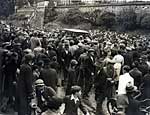 Charlotte Bryant's Execution
Charlotte Bryant's Execution
An illiterate, 33 year old
Irish woman with five children was hanged at Exeter Prison on 15th July
1936 for poisoning her husband. The anti-capital punishment campaigner
Mrs Van de Elst made an appearance in her Rolls Royce at 8am outside
the prison in protest, with a crowd of about 2 to 3 thousand. Bryant
sent a telegram to King Edward VIII the day before which said "Mighty King, Have pity on your
lowly, afflicted subject. Don't let them kill me on Wednesday. Ask them
to give Mrs Van de Elst an opportunity of saying what will prove my
innocence. From the brink of the cold, dark, grave I am a poor helpless
woman. I ask you not to let them kill me, I am innocent.".
King Edward VIII visited Exeter in June 1936. He became King in January 1936 and abdicated in December 1936.
In 1936 the West of England Sack Company building in Queen Street burnt down and in November of the same year, the Ice-Factory in Bonhay Road burnt down. See Express and Echo report.
The key to the 2000th council house in Exeter was presented to Sir Kingsley Wood, Minister of Housing on 11th March 1937.
Prince Henry, the Duke of Gloucester laid the foundation stone for the new library of the University College of the Southwest on 25th October 1937.
│ Top of Page │